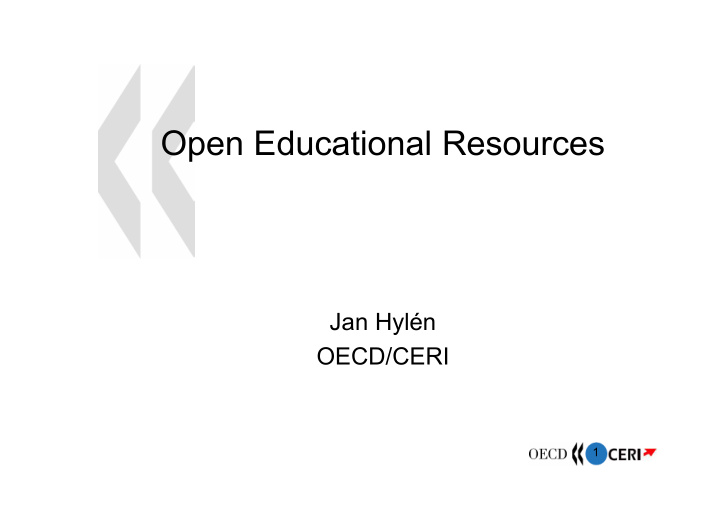



Open Educational Resources Jan Hylén OECD/CERI 1
Technology trends in HE (1) � IT use in education growing for some time but mostly outside classroom settings: – Administration – Information � Now signs that IT is entering core educational activities – “On-line education is growing by degrees” – appr. 20% a year (Sloan Cons. 2005) – “E-learning is becoming increasingly prominent in higher education” (OECD 2005) 2
Technology trends in HE (2) � Growing competition in HE – knowledge and learning resources are often considered as key intellectual property � Still institutions and individuals are sharing their digital learning resources over the Internet openly and for free. � OER Project: – why this is happening? – who is involved? – what the policy implications of this? 3
4
5
The Swedish Agency for Flexible Learning 6
What is Open Educational Resources? � OER are digitized materials offered freely and openly for educators, students and self-learners to use and re-use for teaching, learning and research. 7
What is Open Educational Resources � OER includes: 1) open courseware and content; 2) open software tools (e.g. learning management systems); 3) open material for e-learning capacity building of faculty staff; 4) repositories of learning objects; 5) free educational courses… 8
9
10
OER is a worldwide movement (1) � 150 Chinese universities with over 450 courses online � 11 French universities (ParisTech), 130 courses � Universia – portal for more than 900 Spanish/Portuguese universities 11
OER is a worldwide movement (2) � 9 Japanese universities in the Japanese OCW Alliance � 7 American universities with OER projects (MIT, Rice, John Hopkins, Tufts, Carnegie Mellon, Utah State Univ.) � Australia and New Zealand � India, Pakistan, Vietnam and South-Africa 12
What do we know about OER? (1) � Growing number of initiatives and resources � Growing number of users – students, teachers and self-learners � In HE, use and production is still mostly a bottom-up activity � Instructors and researchers from all fields involved, but the education sector seems most interested 13
What do we know about OER? (2) � Institutions involved are mostly using own resources or a mix of own + external public funding � Most institutions and individuals co-operate, but about 1/3 work alone � Most significant barriers to use OER: – Lack of skills and time – No reward system for teachers devoting time to use and produce open content 14
Suggested motives for institutions � Altruistic reasons � Leverage on taxpayers’ money by allowing free sharing and reuse � Good PR � Growing competition – new business models are needed � “What you give, you receive back improved” – cuts costs for content development 15
Motives for individuals (preliminary results from survey) � Gaining access to the best possible resources � Creating more flexible materials � Promote scientific research and education as publicly open activities 16
Arguments for open sharing – issues for discussion � If no open sharing of research and learning materials, traditional academic values will be marginalised � Free sharing reinforces research, societal development and diminishes social inequality � In a few years institutions will be expected to have an OER programme, just as they are expected to have a website today 17
Thank you jan.hylen@oecd.org www.oecd.org/edu/oer 18
Recommend
More recommend